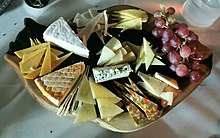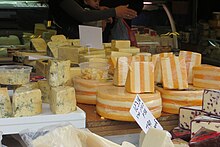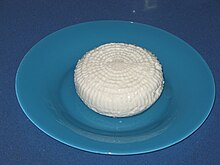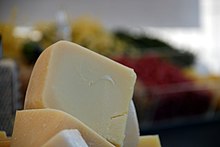| Revision as of 23:25, 30 December 2024 edit77.125.193.177 (talk)No edit summaryTags: Reverted section blanking Mobile edit Mobile web edit← Previous edit | Revision as of 23:26, 30 December 2024 edit undo77.125.193.177 (talk)No edit summaryTags: Reverted section blanking Mobile edit Mobile web editNext edit → | ||
| Line 70: | Line 70: | ||
| ===Har Bracha cheese=== | ===Har Bracha cheese=== | ||
| Har Bracha is a hard, salty cheese that is made from sheep milk. It is produced in the Jewish settlement of Har Bracha near ] and is often used in traditional Jewish cuisine, such as on Shabbat or during festivals. | Har Bracha is a hard, salty cheese that is made from sheep milk. It is produced in the Jewish settlement of Har Bracha near ] and is often used in traditional Jewish cuisine, such as on Shabbat or during festivals. | ||
| ===Kashkaval=== | |||
| Kashkaval is a semi-hard, yellow cheese that is made from cow milk. It has a mild, slightly nutty flavor and a smooth, elastic texture. Kashkaval is often grated or melted and used as a topping for pizza or as a filling for sandwiches. | |||
| ===Kaseri=== | ===Kaseri=== | ||
Revision as of 23:26, 30 December 2024

Cheese has a long and rich history in Israel, dating back to the Israelites who inhabited Israel in ancient times. Over the years, the country has developed a diverse range of cheeses, incorporating a variety of cultural and culinary influences. Today, Israeli cheese is enjoyed both domestically and internationally, with many unique varieties that reflect the country's rich culinary heritage. Below is a List of Israeli cheeses.
History
| This section needs additional citations for verification. Please help improve this article by adding citations to reliable sources in this section. Unsourced material may be challenged and removed. (March 2024) (Learn how and when to remove this message) |


Ancient Israelites
The history of cheese in ancient Israel can be traced back to biblical times. Milk and cheese were an important part of the diet of the ancient Israelites, and cheese-making was a common practice among them. The process of making cheese in ancient Israel was similar to that used today. Milk was first heated and then a coagulant, such as rennet, was added to cause the milk to curdle. The curd was then separated from the whey, which was used to make other foods. The cheese was usually formed into balls or cylinders and then stored in a cool place to age. Cheese was often used as a source of protein and was eaten as a snack or added to dishes to give them flavor.
There were several types of cheese that were popular in ancient Israel. One of the most well-known was called "gevinah," which was a soft, white cheese similar to feta. This cheese was made by adding salt and spices to the curd before it was shaped and aged. Another popular cheese was "marvad," which was a harder cheese that was similar to Parmesan. This cheese was made by pressing the curd and then aging it for several months. Ancient Israel was so active in cheese-making that the Jewish historian Josephus wrote that the ravine which separated Mount Moriah from Mount Zion in Jerusalem was dubbed the "Valley of the Cheese Makers" by locals.
Cheese was also an important part of religious ceremonies in ancient Israel. It was often used as an offering to the gods and was also served during religious festivals and feasts. In the Jewish tradition, cheese is still an important part of the celebration of Shavuot, which commemorates the giving of the Torah on Mount Sinai. It is customary to eat dairy foods, including cheese, on this holiday. Cheese has been an important part of the diet and culture of the ancient Israelites for thousands of years. Cheese-making was a common practice, and several types of cheese were popular, including soft white cheese and hard, aged cheese. Cheese was also used in religious ceremonies, and it continues to play an important role in Jewish tradition today.
1800s to present



The well known Tzfatit, or Tzfat Cheese, a semi-hard salty sheep's milk cheese was first produced in Safed (Tzfat in Hebrew) in 1840 and is still produced there by descendants of the original cheese makers. Tzfatit began to be produced in 1818 at HaMeiri Dairy, established in the home of Meir Arzoni (later HaMeiri), who immigrated from Persia. Tzfatit is a mild curd cheese molded in a basket that gives the cheese distinctive circular striations.
Though the Middle East is considered to be the birthplace of cheese, the development of gourmet artisanal cheese industry in modern Israel has been slower than that of its European and North American counterparts. The success of dairy farming in Israel was unexpected and considered a crowning achievement for the country since it wasn't believed that cows could thrive in Israel's harsh, mostly desert climate. Two main types of cheese, yellow or white, were the usual cheeses consumed by Israelites until recently. In the 1980s, due to the moderate increase in Israel's security and stability, as well as a growing economy and the standard of living starting to improve as a result of Israel transitioning from a developing country to a developed country, and a socialist economy to a free market based economy, around this time, as well the impact of international tourism, privately owned dairies began producing a vast variety of high quality handmade cheeses from cow, goat and sheep's milk. Gilboa cheese is a kosher sheep's milk cheese originating from the Gilboa Mountains in Israel. It is often compared to Manchego cheese, Gilboa has a slightly lemony flavor compared to a Spanish Manchego. Another kosher Israeli cheese not of note is Kadurim Rolled Chevre, which is made of fresh goat cheese and rolled with such flavors as sesame seeds, Herbs de Provence, cracked black pepper, sun-dried tomato, and raspberry.
Varieties
| This section does not cite any sources. Please help improve this section by adding citations to reliable sources. Unsourced material may be challenged and removed. (March 2024) (Learn how and when to remove this message) |

In addition to the cheeses listed below, there are many other types of cheese that are produced in Israel. These include goat cheese, blue cheese, brie, and camembert, among others. Many of these cheeses are produced by small-scale artisanal producers and are available in specialty shops or at local markets.
Israeli cheese is a diverse and vibrant part of the country's culinary heritage. From salty, crumbly feta to creamy, tangy labneh, there is a cheese to suit every taste and occasion. With a rich history and a growing reputation as a producer of high-quality artisanal cheeses, Israel is a key player in the global cheese market.
Gvina levana

Gvina levana is a soft spreadable cheese that is slightly similar to cream cheese and quark cheese, and is used as a spread on bread, dip, and most commonly as an integral ingredient in Israeli cheesecake.
Israeli feta

One of the most popular types of cheese in Israel is Israeli feta. This salty, crumbly cheese is made from sheep or goat milk and has a tangy flavor that pairs well with a wide range of dishes. Israeli feta is often used as a topping for salads or as a filling for pastries such as borekas or bourekas.
Labaneh
Labneh is a soft, creamy cheese that is made from strained yogurt. It has a tangy, slightly sour flavor and a thick, spreadable texture. Labneh is often served as a dip or spread, accompanied by fresh herbs, olives, or other toppings.
Tzfatit

Tzfatit is a white, crumbly cheese made from goat or sheep milk that originates from the city of Safed in the Galilee region of Israel. It has a similar in texture to feta but has a milder, sweeter flavor. Tzfatit is often used as a topping for salads, bread or crackers, or as a filling for pastries.
Akkawi

Akkawi is a soft, white cheese originating from the Israeli port city of Akko, and popular among Arab Israelis that is made from cow or goat milk. It has a mild, slightly salty flavor and a smooth, creamy texture that makes it ideal for spreading on bread or crackers. Akkawi is also commonly used as a filling for pastries such as manakish or fatayer.
Bulgarit

Bulgarit, or Bulgarian cheese is a white, crumbly cheese that is made from sheep milk. It is different than the Bulgarian sirene, Bulgarit is a cheese originating from the Bulgarian Jews, who brought it to Israel and traditionally used it in a variety of dishes such as bourekas. Bulgarit is a tangy, slightly salty flavor and a texture that is similar to feta cheese. Bulgarit is one of the most popular cheeses of Israel today, and is often used in the filling of bourekas, sambusak and similar dishes, as well as an ingredient in salads or as a topping for bread, crackers or even watermelon.
Kefir Cheese
Kefir cheese is a soft, creamy cheese that is made from kefir, a fermented milk drink. It has a tangy, slightly sour flavor and a spreadable texture. It is often used as a dip or spread and is a popular addition to breakfast dishes.
Har Bracha cheese
Har Bracha is a hard, salty cheese that is made from sheep milk. It is produced in the Jewish settlement of Har Bracha near Shechem and is often used in traditional Jewish cuisine, such as on Shabbat or during festivals.
Kaseri
Kaseri is a semi-hard, yellow cheese that is made from sheep milk originally from Greece. It was brought to Israel by Greek Jews, and is now made by several companies locally. It has a nutty, slightly sweet flavor and a crumbly texture. Kaseri is often used as a topping for salads, pizza, or other dishes.
Aris Cheese
Aris cheese is a soft, spreadable cheese that is made from cow milk. It has a mild, creamy flavor and a texture that is similar to cream cheese. Aris cheese is often used as a filling for pastries or as a topping for sandwiches.
Shifra Cheese
Shifra cheese is a semi-hard, yellow cheese that is made from cow milk. It has a nutty, slightly sweet flavor and a firm texture. Shifra cheese is often used as a topping for salads or as a filling for sandwiches.
Galil Cheese

Galil cheese is a semi-hard, yellow cheese that is made from cow milk. It has a nutty, slightly sweet flavor and a smooth, creamy texture. Galil cheese is often used as a topping for pizza or as a filling for sandwiches.
Adom Cheese
Adom cheese is a soft, spreadable cheese that is made from cow milk. It has a mild, slightly tangy flavor and a texture that is similar to cream cheese. Adom cheese is often used as a filling for pastries or as a topping for sandwiches.
Labaneh
Labaneh is a soft, creamy cheese that is made from strained yogurt. It has a tangy, slightly sour flavor and a thick, spreadable texture. Labaneh is often served as a dip or spread, and is commonly enjoyed with pita bread or vegetables.
Eshkeneh Cheese
Eshkeneh cheese is a soft, spreadable cheese that is made from cow milk. It has a mild, slightly sweet flavor and a texture that is similar to cream cheese. Eshkeneh cheese is often used as a filling for pastries or as a topping for sandwiches.
Jibneh Arabieh
Jibneh Arabieh is a white, crumbly cheese that is made from goat or sheep milk. It is commonly made in the Galilee in the north of Israel as well as in the Negev Desert in the south of Israel. It has a tangy, slightly salty flavor and a texture that is similar to feta cheese. Jibneh Arabieh is often used in salads or as a topping for bread or crackers.
Charisma cheese
Charisma cheese is a semi-hard, yellow cheese that is made from cow milk. It has a nutty, slightly sweet flavor and a smooth, creamy texture. Charisma cheese is often used as a topping for pizza or as a filling for sandwiches.
Rosh Hanikra Cheese
Rosh Hanikra cheese is a soft, spreadable cheese that is made from cow milk. It has a mild, slightly sweet flavor and a texture that is similar to cream cheese. Rosh Hanikra cheese is often used as a filling for pastries or as a topping for sandwiches.
See also
References
- Gur, Janna. The Book of New Israeli Food: A Culinary Journey.
- Gurevich and Wajswol, Katya and Eran. Cheese from the Land of Milk and Honey: A Guide to Israeli Cheese.
- Ottolenghi and Tamimi, Yotam and Sami. Jerusalem: A Cookbook. Ten Speed Press.
- Rothfeld, Steven. Israel Eats.
- Mayer-Chissick, Uri. The Secret Life of Cheese: The Complete Guide to Cheese and Cheese-Making in Israel.
- Gitlitz and Davidson, David and Linda. Food in Israel: A Mediterranean Journey.
- Gur, Janna. Israel: A Culinary Journey.
- Nathan, Joan. The Foods of Israel Today.
- ^ Josephus, Flavius. Antiquities of the Jews (93 EC).
- Goodman Kaufman, Carol. "The Israeli History of Cheese — and How To Make Your Own". The Forward.
- "The HaMeiri Cheeses". Retrieved 1 May 2015.
- Blackburn, Nicky (May 16, 2018). "It's not about the money for Israel's boutique cheese makers". ISRAEL21c. Retrieved Apr 2, 2023.
- "After the 'Cottage-Cheese Protests,' Israel's Boutique Cheese-Makers Prepare for a Busy Shavuot - Tablet Magazine". Retrieved Apr 2, 2023.
Further reading
- "The Book of New Israeli Food: A Culinary Journey" by Janna Gur - This book includes a chapter on Israeli cheese and features information about various Israeli cheese producers.
- "Cheese from the Land of Milk and Honey: A Guide to Israeli Cheese" by Katya Gurevich and Eran Wajswol - This book provides a comprehensive guide to the cheeses of Israel, including their history, production methods, and flavor profiles.
- "Jerusalem: A Cookbook" by Yotam Ottolenghi and Sami Tamimi - While not solely focused on cheese, this cookbook includes several recipes featuring Israeli cheeses, such as labneh and feta.
- "Israel Eats" by Steven Rothfeld - This cookbook includes a section on cheese and dairy in Israel, with information about the country's cheese traditions and recipes featuring Israeli cheeses.
- "The Secret Life of Cheese: The Complete Guide to Cheese and Cheese-Making in Israel" by Uri Mayer-Chissick - This book offers a detailed look at Israeli cheese, including its history, production, and culture.
External links
![]() Media related to Cheese from Israel at Wikimedia Commons
Media related to Cheese from Israel at Wikimedia Commons
| Cheese | |
|---|---|
| Types | |
| Animal milk | |
| Regions | |
| Special designations | |
| Organizations | |
| List articles | |
| Miscellaneous | |
| Israeli cheeses | |
|---|---|
| Cheeses | |
| Israeli cuisine | |
|---|---|
| List of dishes | |
| History | |
| Breads | |
| Salads |
|
| Dips and condiments | |
| Sandwiches | |
| Fish | |
| Soups |
|
| Meat | |
| Fried foods | |
| Pasta | |
| Grains and side dishes | |
| Desserts | |
| Alcohol | |
| Other drinks |
|
| Fruits and vegetables | |
| Other ingredients | |
| Cheeses | |
| Israeli restaurants domestically and abroad | |
| Jewish cuisine | |||||||||||
|---|---|---|---|---|---|---|---|---|---|---|---|
| History | |||||||||||
| Types | |||||||||||
| Religious dietary laws and related terms | |||||||||||
| Chefs | |||||||||||
| Religious foods | |||||||||||
| Breads |
| ||||||||||
| Sweets |
| ||||||||||
| Pastries | |||||||||||
| Fried foods |
| ||||||||||
| Dumplings, pastas and grain dishes |
| ||||||||||
| Casseroles and savory baked dishes | |||||||||||
| Snacks and other baked goods | |||||||||||
| Sandwiches | |||||||||||
| Egg dishes | |||||||||||
| Meat dishes | |||||||||||
| Fish dishes | |||||||||||
| Salads and pickles | |||||||||||
| Vegetable dishes | |||||||||||
| Soups and stews | |||||||||||
| Cheeses and other dairy products | |||||||||||
| Condiments, dips and sauces | |||||||||||
| Beverages | |||||||||||
| Herbs, spices and seasonings | |||||||||||
| Eateries | |||||||||||
| Related lists | |||||||||||